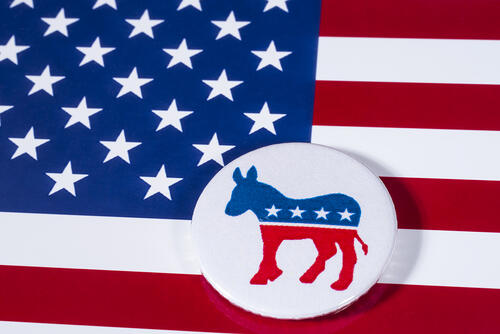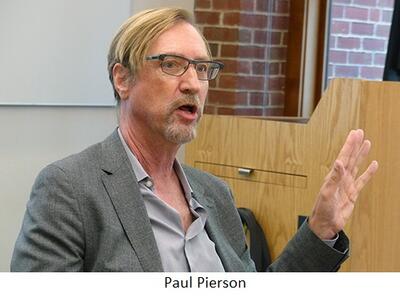Researching the Changing Democratic Party: Insights from ISPS’s New Initiative on the American Political Economy

Nothing in the U.S. Constitution expressly authorizes or even mentions political parties. Eight years after the Constitution’s ratification, George Washington warned in his presidential farewell address that political factions could obstruct the execution of the law and seek power beyond the will or best interests of the American people.
And yet today, the country is regularly divided into red and blue states, with a majority of voters choosing one of the two dominant political parties. The functioning of the federal government and the fate of sweeping issues before the Supreme Court can hang on the party affiliation of a single seat in the U.S. Senate. Third-party candidates for president often talk of broadening democratic choice, but in reality in our current system they function mainly as spoilers, siphoning votes from the Democratic or Republican nominee.
Given the rise of nationalized partisan polarization and the influence of the two parties on how the government operates at every level, we need to understand what they are, how they are influenced, how they evolve, and how they shape events within our capitalist democracy. At the Institution for Social and Policy Studies (ISPS), a new initiative expands our capacity for such investigations.
Faculty fellow Jacob Hacker created the American Political Economy Exchange (APEX) to research how the country’s political and economic systems interact. For the new initiative’s first event last week, Hacker, the Stanley B. Resor Professor of Political Science, invited Paul Pierson, his frequent co-author and the John Gross Professor of Political Science at the University of California at Berkeley, for a presentation and conversation on the factions, agenda, and actions of the Democratic Party.
Drawing on work he conducted with Hacker — with assistance from ISPS predoctoral fellow Amelia Malpas and Ph.D. candidate Sam Zacher — Pierson described how the Democratic Party has been transformed over the past generation by changes in its voter base and the groups allied with it.
Pierson described the Democratic Party as predominantly an urban/suburban coalition, demographically diverse and gaining strength in densely populated metropolitan areas where economic activity is increasingly concentrated. He linked these changes to the rise of what he called a “density paradox” in American party politics.
The paradox, according to Pierson, is that density is rewarded in the contemporary economy — urban “agglomeration hubs” now drive productivity and innovation — but penalized by the American political system. Voters in dense metro areas are disadvantaged relative to those in less populated locales by a highly malapportioned U.S. Senate, as well as by the (smaller) biases of the Electoral College for choosing the president. They are also disadvantaged because they are “packed” — due to natural clustering and GOP gerrymandering at the state level — into metro districts that Democrats win by a landslide, reducing their overall representation in Congress and state legislatures.
These disadvantages linked to density can build on one another. For example, Pierson noted that the Democrats have won the national popular vote in seven of the eight last presidential elections, and yet Republican appointees to the Supreme Court hold a 6-3 advantage.
“If you went back to the framers of the Constitution and told them this, they would scratch their heads and ask how this could be possible,” Pierson said. “Well, the nature of the geographic divide in a highly nationalized and polarized politics tells us how it’s possible.”
Pierson emphasized that having two parties divided by density has scrambled the economic character of their electoral coalitions. With both affluent suburbanites and poorer metro voters backing the Democratic Party, the party has become an uneasy alliance between the winners in an unequal economy and those who are losing ground. Moreover, because dense places are highly racially and ethnically diverse, the parties have split on whether they see multi-racial democracy as an opportunity or a threat.
Pierson’s central point was that we shouldn’t assume that the parties will naturally reorient around the economic interests of their transformed voting blocs. That is because parties rely on what political scientists sometimes call “intense policy demanders” for resources, voter mobilization, and sending cues to voters about who is an ally and who is a foe. The National Rifle Association would be an example of such a group for Republicans, he said. Labor unions — more emboldened today than in a generation — are an example on the Democratic side.
“Both major political parties are broad coalitions that need to appeal to voters but also to organized interests, particularly when thinking not just about elections but governance,” Pierson said. “And the significance of these long coalitions only increases in a context of intense partisan polarization.”
Pierson said that the sharp contrast between today’s Democrats and Republicans increases the role of special interest groups, creating stronger incentives for groups to pick a side. In addition, the growth in the sense of voters’ identifying with one party and directing their animosity toward the other party — known as affective polarization — increases what he calls an “electoral blind spot.”
“The more you have affective polarization among voters, the more room there is for party leaders to hand out policy rewards to the intense policy demanders,” he said. “Even if these are not policies the median voter might be enthusiastic about.”
To gain and hold power, Democrats require support from privileged incumbents, creating tensions over race and ethnicity, income and wealth, gender, and age and between insiders and outsiders, urban and suburban residents, and immigrants and native-born voters, Pierson said.
“It’s interesting to study as a social scientist, but it is critical as a citizen to think about this,” he said. “Is it possible to combine genuine movement toward social inclusion with sustained political success? That’s the challenge that the Democratic Party faces.”
Pierson praised the assembled faculty and graduate students from across the social sciences, the law school, and the school of management as a valuable testing ground for ideas that he and Hacker plan to present in an upcoming book.
Pierson and Hacker said they have chosen to study the Democrats after years of studying Republicans in part because Democrats have received much less attention from political scientists than their opponents.
“The degree to which Democrats can navigate these turbulent waters is critical to American democracy,” Hacker said. “Right now, they are an essential bulwark against democratic backsliding and the main potential pathway for expanding social inclusion. That is why it is so crucial to better understand how and whether they can manage their internal tensions to effectively gain and wield power.”
ISPS Director Alan Gerber expressed his great enthusiasm for APEX, which plans to hold another event in November to officially launch the center.
“The creation of APEX at ISPS provides an invaluable framework for our understanding of how the political and economic systems in the United States function together,” Gerber said. “This new initiative significantly expands the scope of ISPS’s efforts and will produce scholarship to explain and help navigate the most important political and governance challenges we face as a country.”